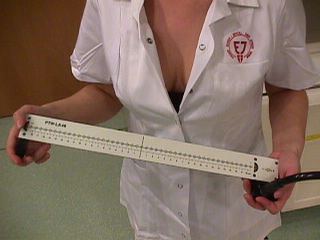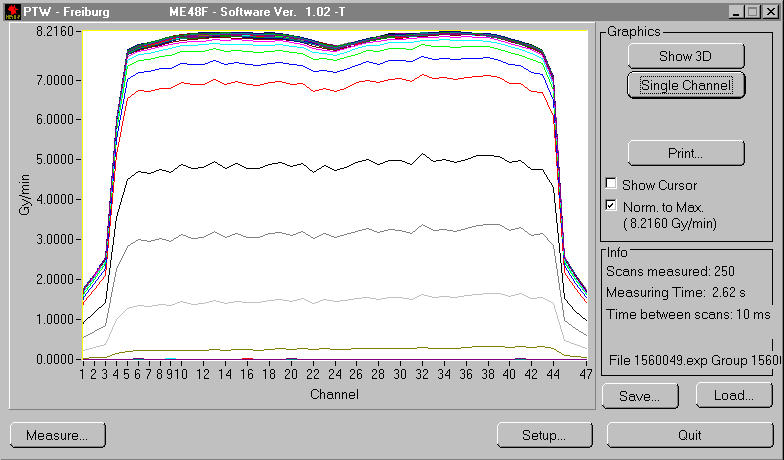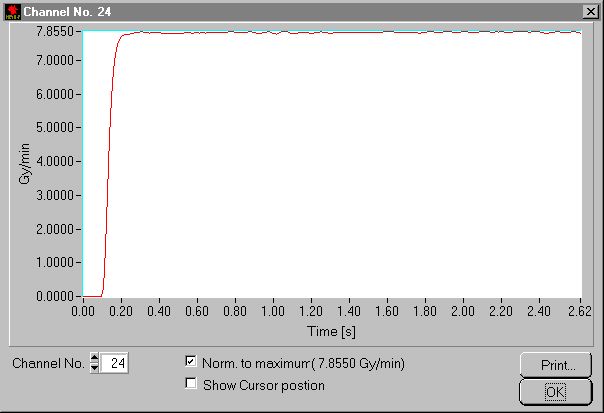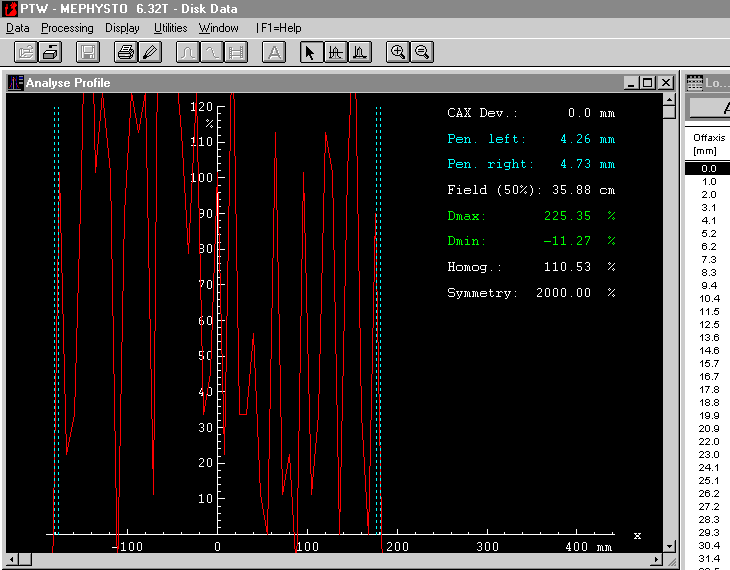Fast Beam Measurements with
the LA48
Preliminaries
The introduction of new
treatment techniques (conformal radiotherapy, intensity modulated radiation
therapy - IMRT) have underlined the importance to investigate dynamic beam characteristics
like the startup behavior of a medical linear accelerator. As the number of
treatment fields per session of a conformal treatment increases, the number
of monitor units for each portal gets smaller. If the beam only stabilizes after
a considerable fraction of time with respect to symmetry and dose rate, the
startup phase may affect the dose distribution in the target region. The same
holds for quasi-dynamic treatments (step-and-shoot technique), where a sequence
of static fields with different shapes is delivered to the treatment volume
with the gantry at a fixed position. Here the beam-on sequence is performed
several times with small monitor unit values for the individual segments.
An influence on dose distribution
is also imaginable in situations where the dose rate is regulated dynamically
under control of a computer. With Varian's Enhanced Dynamic Wedge (EDW), in
the first part of the EDW treatment a certain fraction of the total dose is
delivered to the full field (open field phase). Then one of the upper jaws starts
to sweep the field (collimator sweep phase) until the jaws are in an almost
closed position. Beam is on during the whole treatment, but dose rate can vary
quite significantly, especially at the transition from the open field phase
to the collimator sweep phase.
The Varian Dynamic Multileaf
Collimator (DMLC) is a dynamic treatment option that includes both the step-and-shoot
technique and the continuous beam and motion technique. With the former, dose
rate is servoed to a user defined value during the 'shoot' segments of the treatment,
followed by move-only segments where the leaves move to the next shape. At the
transition a sharp drop of dose rate to zero is achieved by delaying all gun
pulses to prohibit beam output, but the beam stays actually on during the move-only
segments. It is certainly interesting to measure beam quality under such rapid
changes of dose rate. The continuous beam and motion technique of the DMLC has
no such sharp changes in dose rate, since pulses are only dropped if one or
more leaves would have to exceed maximum leaf speed. Generally, the MLC shape
is changing constantly during beam-on. At each instant, the actual shape is
calculated as the result of a linear interpolation between two shapes and their
respective dose fractions (between 0.0 and 1.0).
 Standing wave accelerators should perform
better during startup compared to travelling wave machines. We investigated
the startup behavior of our two Clinacs 2300C/D which are of the former type.
The machines are equipped with Electronic Portal Imaging Devices (PortalVision),
which require special dose rate control to ensure good image quality. During
photon treatments, dose rate is controlled by a Pulse Length Servo, for Electron
treatments a Pulse Drop Servo (PDS) is used. A bad startup performance could
also have influence on the image quality of a portal image, which requires an
average dose of 9 monitor units (MU) in our department. If the image is acquired
before the beam stabilizes, image quality could be affected.
Standing wave accelerators should perform
better during startup compared to travelling wave machines. We investigated
the startup behavior of our two Clinacs 2300C/D which are of the former type.
The machines are equipped with Electronic Portal Imaging Devices (PortalVision),
which require special dose rate control to ensure good image quality. During
photon treatments, dose rate is controlled by a Pulse Length Servo, for Electron
treatments a Pulse Drop Servo (PDS) is used. A bad startup performance could
also have influence on the image quality of a portal image, which requires an
average dose of 9 monitor units (MU) in our department. If the image is acquired
before the beam stabilizes, image quality could be affected.
Coming to the point ...
This Winter 1998 PTW Freiburg
introduced an extension to their LA48 Linear Array (Fig.1). The array consists
of 47 ionization chambers (2.5 * 2.5 mm, 8 mm spacing). A new amplifier with
a time constant of 10 ms (ME48F) allows measurement of 100 dose profiles
per second. The acquisition of the profile itself takes 2 ms, after another
8 ms the next profile can be measured. The channels are read out sequentially,
which is quite fast (42.5 microseconds per channel!), but this can still lead
to artefacts, if the beam rises fast enough (as you will see below).
The measurement starts after
a user-selected dose rate level (e.g., 0.02 Gy/min) is reached. A user selectable
number of profiles (10 in my example) before reaching the level are also stored.
Data can be exported to PTW's Mephysto software for further analysis.
Example
The array was mounted in-plane
in the PTW waterphantom (without water), SSD was set to 80cm, so the jaws could
be set to 40 by 40 cm. The Clinac was set to HiX (15MV), Dose rate 600MU/min,
and beamed-on. Scan time was 2ms, repetition time 10ms. Fig. 2 shows the first
250 profiles in the ME48F software.
 |
|
Fig.2: Measuring window
of ME48F software showing 250 profiles.
|
By pressing the 'Single
Channel' button, one gets the time-dependent dose rate of a user selectable
channel (Nr. 24 shows the central axis): see Fig. 3.
 |
|
Fig.3: Dose rate at
central axis
|
As can be seen in Fig. 3,
at t=100ms Beam-on was pressed. The beam rises in no-time-at-all and reaches
95% of maximum dose rate (7.855 Gy/min) after 79 milliseconds (t=179ms).
The first true beam profiles
above noise level were recorded at t=104ms and t=114ms. The following animation
(Fig.4) shows all profiles (even the 10 before reaching the trigger level, so
they are just noise) normalized to 100% at central axis (i'm sorry that the
profile at t=188ms is missing, but there is nothing special about it -- and
doing all these screen shots, converting them to GIFs and aligning the frames
is a pain-in-the-ass!). The bad symmetry of the first few curves (especially
at t=104ms and t=114ms) comes from the measurement system, not from the Clinac.
This was checked by mounting the array the other way around because with the
rotated setup curves were still rising to the right. PTW told me that they checked
their measurement system on Siemens machines and found no such effect ...
So after measuring all combinations
of Energy (also Electrons!) and dose rate from 1Gy/min to 10Gy/min I found out
that the Clinac beam rises absolutely symmetrical. The measurement system is
state-of-the-art and not cheap, but it gets to its limit at our machines. Nevertheless,
it's a very fine system and I can recommend it to anyone who is interested in
the startup behavior of his machines. To be honest: the problem of beam quality
after 14 milliseconds is somewhat academic (dose rate at 14ms after beam-on
is 18%).
 |
|
Fig.4: Beam developement
for the first 388 milliseconds. The 'off-axis' value to the right
multiplied by ten gives the time (beam starts at t=100ms).
|
So if you find this interesting,
stay tuned! I already performed some measurements of Dynamic MLC beams ...
back to Medical Physics home
Last modified: Feb.19
1999HK
 Standing wave accelerators should perform
better during startup compared to travelling wave machines. We investigated
the startup behavior of our two Clinacs 2300C/D which are of the former type.
The machines are equipped with Electronic Portal Imaging Devices (PortalVision),
which require special dose rate control to ensure good image quality. During
photon treatments, dose rate is controlled by a Pulse Length Servo, for Electron
treatments a Pulse Drop Servo (PDS) is used. A bad startup performance could
also have influence on the image quality of a portal image, which requires an
average dose of 9 monitor units (MU) in our department. If the image is acquired
before the beam stabilizes, image quality could be affected.
Standing wave accelerators should perform
better during startup compared to travelling wave machines. We investigated
the startup behavior of our two Clinacs 2300C/D which are of the former type.
The machines are equipped with Electronic Portal Imaging Devices (PortalVision),
which require special dose rate control to ensure good image quality. During
photon treatments, dose rate is controlled by a Pulse Length Servo, for Electron
treatments a Pulse Drop Servo (PDS) is used. A bad startup performance could
also have influence on the image quality of a portal image, which requires an
average dose of 9 monitor units (MU) in our department. If the image is acquired
before the beam stabilizes, image quality could be affected.

